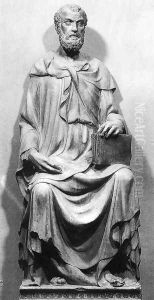Bernardo Ciuffagni Paintings
Bernardo Ciuffagni, born in 1388 in Florence, Italy, emerged as a distinguished sculptor during the early Renaissance, a period marked by the rebirth of classical art and architecture and a renewed interest in humanism. Ciuffagni's life and career were deeply rooted in the artistic and cultural milieu of Florence, a city that was at the forefront of the Renaissance movement. His contributions to sculpture are reflective of the period's inclination towards realism, attention to human emotion, and incorporation of classical themes.
Ciuffagni was trained in the workshop of Lorenzo Ghiberti, one of the most prominent sculptors and goldsmiths of the time. This training provided him with a solid foundation in the techniques and principles of Renaissance art, as well as exposure to the innovative ideas that were circulating in Florence's artistic circles. Under Ghiberti's guidance, Ciuffagni developed a keen understanding of the human form, a mastery of bronze casting, and an appreciation for the classical past, all of which would significantly influence his later works.
Throughout his career, Ciuffagni contributed to several important projects in Florence and beyond. Notably, he worked on the famous doors of the Florence Baptistery, an endeavor that was overseen by his mentor, Ghiberti. Ciuffagni's work on the Baptistery doors allowed him to showcase his skill in relief sculpture and his ability to convey complex narratives through art. In addition to his contributions to the Baptistery, he executed a number of standalone sculptures and participated in various architectural projects, further cementing his reputation as a versatile and skilled artist.
Ciuffagni's style is characterized by its elegance, attention to detail, and emotional depth. His sculptures often exhibit a remarkable sense of movement and realism, bringing to life the stories and figures of antiquity. Despite the high quality of his work, Ciuffagni has not attained the same level of fame as some of his contemporaries, such as Donatello or Ghiberti. However, his contributions to the Renaissance and to the development of sculpture during this period remain significant.
Bernardo Ciuffagni passed away in 1452 in Florence. His legacy is preserved in the sculptures and projects he contributed to, which continue to be appreciated for their artistic merit and historical importance. Through his works, Ciuffagni remains a testament to the creativity and craftsmanship of Renaissance artists and the enduring appeal of their contributions to the world of art.
